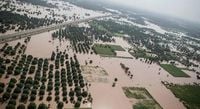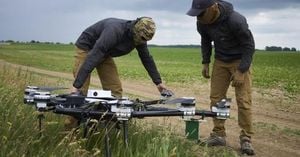As the floodwaters that ravaged Pakistan’s Punjab province in August and September 2025 finally begin to recede, millions of residents are returning home—only to face a new wave of hardship. According to the Associated Press, most of the 2.6 million people displaced by the record-breaking floods have found their houses damaged and their crops destroyed, a grim reality that’s left many families unsure of how to rebuild their lives.
The floods, triggered by relentless monsoon rains and exacerbated by overflowing dams in neighboring India, have devastated communities across Punjab. The Punjab Disaster Management Authority confirmed that August 2025 brought the province’s worst flooding on record, damaging an astonishing 2.5 million acres of farmland and claiming at least 118 lives, as reported by Punjab relief commissioner Nabil Javed. In some areas, the scale of destruction is reminiscent of the catastrophic monsoon season of 2022, which killed 1,739 people nationwide and caused an estimated $40 billion in damage.
For many families, the ordeal didn’t end with the receding waters. Survivors describe returning to villages only to discover the full extent of their losses. In Qatalpur, 45-year-old Mohammad Mohsin broke down as he surveyed his cracked, unstable house. “The flood destroyed us, our crops are gone,” he told Associated Press. “We survived the waters, but I fear one day the roof will fall on us. My house needs urgent repair, but so far we have received no government aid.”
Others, like Parveen Bibi, 39, have been left with little more than the ruins of their homes. “During the flood, we stayed on the riverbank and got food from the government,” she recounted. Yet, she said, no official had visited to assess her family’s losses.
In Khanewal district, Sajjad Hussain, a 52-year-old farmer, spent a week under the open sky after his village was submerged. “Now that the water has gone, I am going back,” he said. “Even if the government only gives me a tent, I will thank God.”
The swelling of the Ravi, Chenab, and Sutlej rivers was described by Irfan Ali Kathia, director general of the Punjab Disaster Management Authority, as “unprecedented.” Fortunately, as of mid-September, water had receded in most areas, though it continued to move south toward Sindh province.
Amid this devastation, Punjab’s government has moved to provide relief. On September 18, 2025, Punjab Chief Minister Maryam Nawaz Sharif announced a comprehensive compensation package for flood-affected residents, particularly in hard-hit Wazirabad. Homeowners whose properties were completely destroyed will receive Rs.1 million, while those with partially damaged homes are set to get Rs.500,000. The package also addresses the needs of the agricultural sector: flood-affected farmers will receive Rs.20,000 per acre to help offset crop losses, and livestock owners will be compensated Rs.500,000 for cows and buffaloes, and Rs.50,000 for goats and sheep. According to ProPakistani, these measures are intended to provide immediate financial relief and support the rebuilding of both homes and livelihoods.
“This bold move by the Punjab CM aims to provide immediate financial relief to the flood-hit families and help them rebuild their lives,” reported ProPakistani. The Punjab government has promised to begin a survey to assess the damage to crops, homes, and infrastructure, a process expected to start the week after September 18, 2025.
But for many, financial support is only part of the recovery. The floods have caused widespread disruption to health services, leaving families vulnerable to disease and without access to basic medical care. In response, Al-Shifa Trust Eye Hospital, based in Rawalpindi, has stepped in to fill the gap. According to DNA News Agency, the trust has treated more than 15,000 flood victims across Punjab and Khyber Pakhtunkhwa this month alone, organizing eight emergency medical camps in areas such as Swat, Buner, Swabi, Sambrial, Sialkot, Narowal, Wazirabad, and Kasur.
These camps provided eye checkups, general consultations, and urgent treatment for diseases like allergic conjunctivitis, viral eye infections, keratitis, and various bacterial infections—many of which are linked to contaminated water and poor hygiene. More serious conditions, such as acanthamoeba keratitis and leptospirosis, also surfaced among those exposed to floodwaters. Dr. Najam, General Manager of Al-Shifa Centre for Community Ophthalmology, explained that the trust distributed over 2,000 prescription eyeglasses, provided eye drops and ointments, and screened more than 3,000 patients for diabetes and hypertension. In addition, 2,500 food packets and 3,500 water purification tablets were handed out to families in need.
“For many, these camps provided the first medical help since rising waters swept away homes, livestock and health facilities, leaving entire communities stranded without doctors or medicines,” DNA reported. In Punjab alone, five locations served close to 9,800 patients, while three camps in Khyber Pakhtunkhwa reached over 5,200 people. The trust is now planning to expand its mobile clinics, equipped with ophthalmic equipment, medicines, and trained staff, to reach even more affected communities in the coming weeks.
Al-Shifa Trust’s efforts go beyond immediate medical care. The organization is working with local community leaders to raise awareness about preventing waterborne diseases and eye infections, distributing educational materials on hygiene and safety alongside medical supplies. This holistic approach aims not only to heal but also to empower communities to rebuild their health and resilience after the disaster.
International support has also begun to trickle in. On September 18, 2025, Malaysia announced a humanitarian aid package of US$150,000 through its Ministry of Foreign Affairs’ Disaster Fund, with US$100,000 earmarked specifically for flood victims in Pakistan. The contribution was presented by Malaysian Foreign Minister Datuk Seri Mohamad Hasan to Pakistan’s High Commissioner to Malaysia, Syed Ahsan Raza Shah. In a statement, Malaysia’s Foreign Ministry affirmed, “Malaysia reaffirms its solidarity with the government and people of Pakistan in the wake of severe floods in Khyber Pakhtunkhwa, Punjab, Sindh, and Gilgit-Baltistan, which have resulted in the loss of lives, widespread displacement, and significant damage to infrastructure and livelihoods.”
Relief Commissioner Nabeel Javed updated that, as of September 18, 2025, the total number of flood-related deaths in Punjab had reached 112, with 4.7 million people affected. The Malaysian contribution is intended to help ease the hardships endured by victims and support ongoing relief and recovery efforts. Malaysia’s Disaster Fund, established in 2006, continues to welcome contributions from individuals, corporations, and NGOs to support disaster-stricken communities worldwide.
Pakistan’s road to recovery will be long and fraught with challenges. But as families return to their battered villages, the combined efforts of local authorities, charities, and international partners are providing a crucial lifeline—one that, with continued support, may help communities in Punjab and beyond reclaim their homes, health, and hope for the future.




